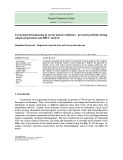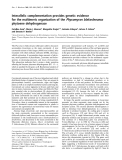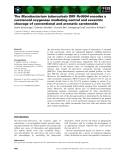
Analysis of carotenoids
-
An analytical procedure for the analysis of carotenoids in marine sediments rich in organic matter has been developed. Analysis of these compounds is difficult; the application of methods used by other authors required optimization for the samples studied here.
 14p
14p  tocectocec
tocectocec
 25-05-2020
25-05-2020
 28
28
 1
1
 Download
Download
-
The Phycomyces blakesleeanus wild-type is yellow, because it accumulates b-carotene as the main carotenoid. A new carotenoid mutant of this fungus (A486) was isolated, after treatment with ethyl methane sulfonate (EMS), showing a whitish coloration. It accumulates large amounts of phytoene, small quantities of phyto¯uene, f-carotene and neurosporene, in decreasing amounts, and traces of b-carotene. This phenotype indicates that it carries a leaky mutation aecting the enzyme phytoene dehydrogenase (EC 1.3.-.-), which is speci®ed by the gene carB....
 7p
7p  research12
research12
 01-06-2013
01-06-2013
 48
48
 5
5
 Download
Download
-
Mycobacterium tuberculosis, the causative agent of tuberculosis, is assumed to lack carotenoids, which are widespread pigments fulfilling important functions as radical scavengers and as a source of apocarotenoids. In mam-mals, the synthesis of apocarotenoids, including retinoic acid, is initiated by theb-carotene cleavage oxygenases I and II catalyzing either a central or an excentric cleavage of b-carotene, respectively.
 12p
12p  viettel02
viettel02
 19-02-2013
19-02-2013
 30
30
 2
2
 Download
Download
CHỦ ĐỀ BẠN MUỐN TÌM















